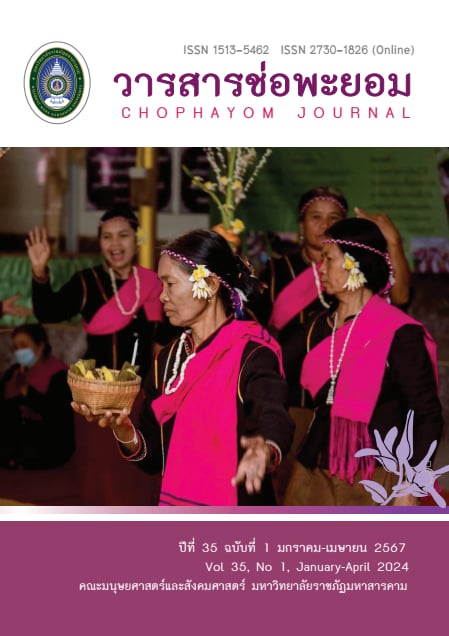Mudmee Weaving: Preserving the Artistic Tapestry of Life in Songkwae Town
Keywords:
Mudmee Weaving, Preserving the Artistic Tapestry of Life, SongKwae townAbstract
Mudmee weaving is a traditional art of weaving indigenous fabric. It involves weaving fabric from threads that have undergone a process of tie-dyeing before being woven to create patterns and colors according to preference. This article focuses on presenting the unique beauty of Mudmee silk fabric from Ban Muang Hom, Wang Thong District, Phitsanulok Province, also known as "Songkwae" town. This fabric is a cultural heritage product reflecting the local wisdom and pride in the hometown, which is manifested through distinctive patterns of the Lanna region, especially the peacock feather pattern, chicken comb pattern, Songkwae pattern, flowing water pattern, or Nan river pattern. These patterns are like the streams of the heart that never cease to flow, continuously accompanying the flow of time, becoming intertwined lives. The concept of the "cultural stream" is reflected in interviews with experts, weavers, local fabric weaving wisdom, and local fabric collectors, explaining the deep meaning and significance hidden in the fabric patterns, and the factors that contribute to the beautiful way of life, akin to delicately threading a needle onto fabric to embroider and weave. The intrinsic identity of spiritual value emerges in a tangible form, or in other words, it is the creation of methods that can sway or awaken people's consciousness to the value of beauty in every moment of reminiscing about their native homeland.
Keywords: Mudmee Weaving, Preserving the Artistic Tapestry of Life, SongKwae town
References
กรมศิลปากร. (2563). พิพิธภัณฑสถานแห่งชาติ เชียงใหม่ ผ้าไหมมัดหมี่. สืบค้นเมื่อ 24 เมษายน 2567, จาก https://www.finearts.go.th/chiangmaimuseum/view/.
กองส่งเสริมวัฒนธรรมมหาวิทยาลัยนเรศวร. (2560). สถานอารยธรรมศึกษาโขง-สาละวิน มหาวิทยาลัยนเรศวรจับมือพัฒนาชุมชน สร้างสรรค์ 11 ลวดลายผ้าทอเอกลักษณ์จังหวัดพิษณุโลก. สืบค้นเมื่อ 16 พฤษภาคม 2565, จาก https://www.nuac.nu.ac.th/v3/?p=3170
กำจร สุนพงษ์ศรี. (2523). สุนทรียศาสตร์. กรุงเทพฯ: ไทยวัฒนาพานิช.
เผ่าทอง ทองเจือ. (2560). มัดหมี่ หนึ่งในผ้าในวัฒนธรรมอาเซียน. สืบค้นเมื่อ 23 เมษายน 2567, จาก https://www.trueplookpanya.com/education/content/57282/-artfin-art-.
มหาวิทยาลัยศิลปากร. (2543). ผ้าทอพื้นเมืองในภาคเหนือ. กรุงเทพฯ: อมรินทร์พริ้นติ้งแอนด์พับลิชชิ่ง.
เยื้อง ปั้นเหน่งเพ็ชร์. (2564). สุนทรียศาสตร์ในพระบฏล้านนา. เชียงใหม่: มหาวิทยาลัยมหาจุฬาลงกรณราชวิทยาลัย.
สถาบันพัฒนาอุตสาหกรรมสิ่งทอ. (2562). จากกล้าไม้พระราชทานสู่งานวิจัย"ลายดอกปีบ". สืบค้นเมื่อ 5 ตุลาคม 2566, จาก https://www.thaitextile.org/th/insign/detail.961.1.0.html.
สำนักงานประชาสัมพันธ์จังหวัดพิษณุโลก. (2566). ผ้าลายดอกปีบ จังหวัดพิษณุโลก. สืบค้นเมื่อ 5 มกราคม 2567, จาก https://phitsanulok.prd.go.th/th/content/category/detail/id/286/iid/8702 ไม่ปรากฏอ้างอิงในเนื้อเรื่อง.
หอภาพถ่ายล้านนา. (2562). ภาพเขียนจิตรกรรมบนผืนผ้า (พระบฏ) วัดเจดีย์สูง อำเภอฮอด จังหวัดเชียงใหม่. สืบค้นเมื่อ 4 พฤษภาคม 2566, จาก https://cmhop.org/product/.
Downloads
Published
How to Cite
Issue
Section
License
Copyright (c) 2024 Chophayom Journal

This work is licensed under a Creative Commons Attribution-NonCommercial-NoDerivatives 4.0 International License.






